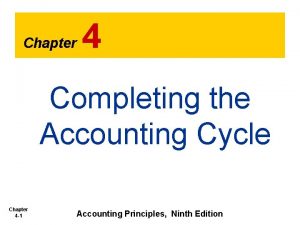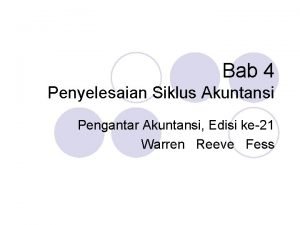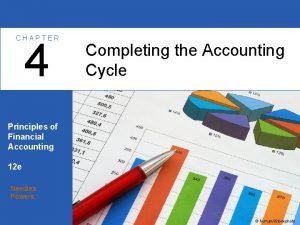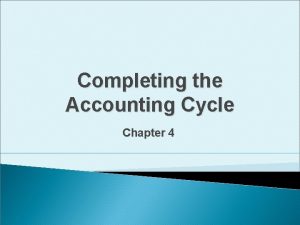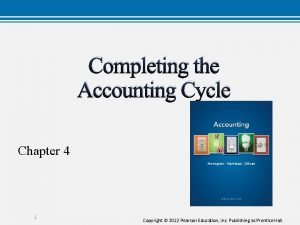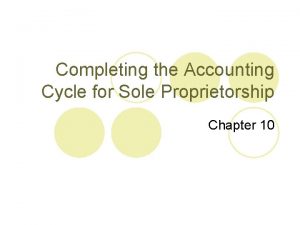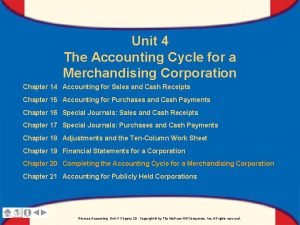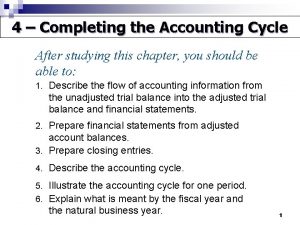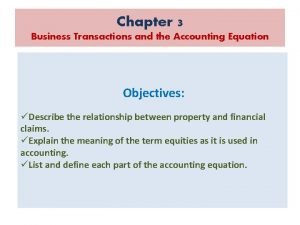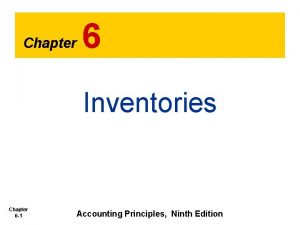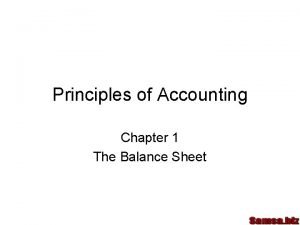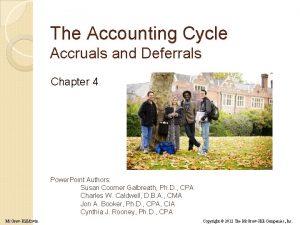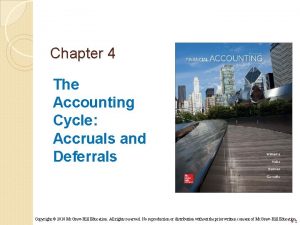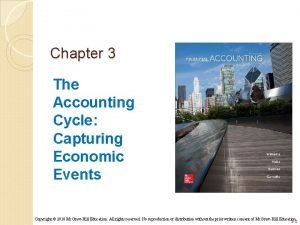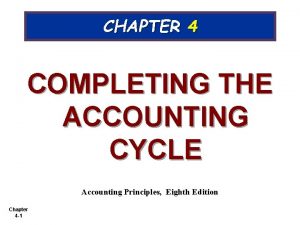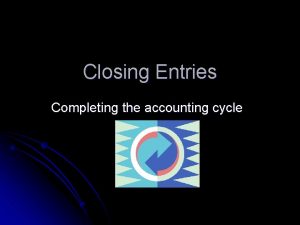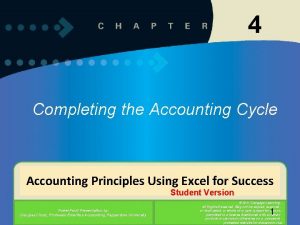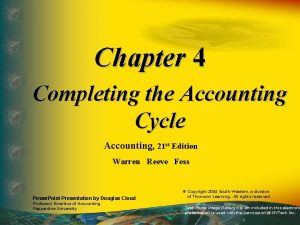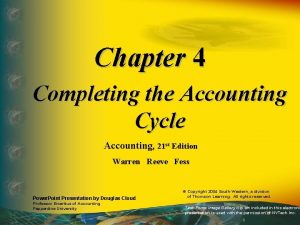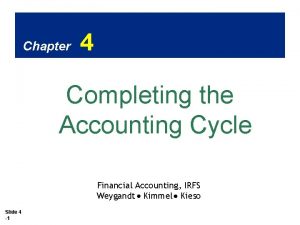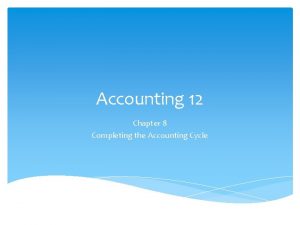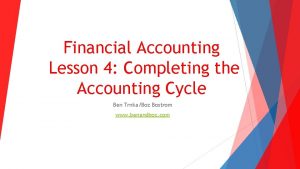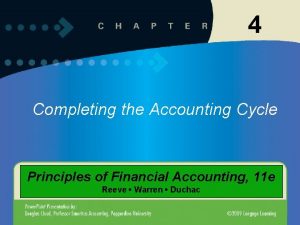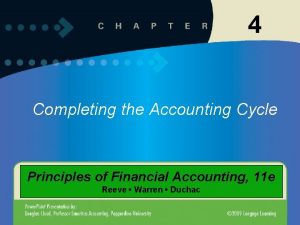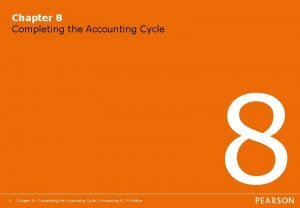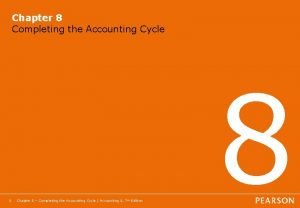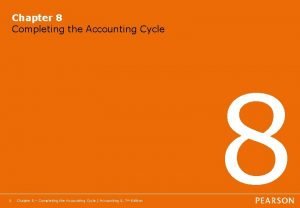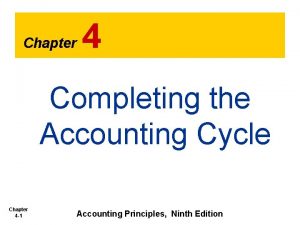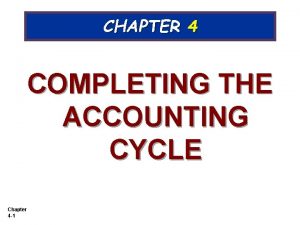CHAPTER 5 COMPLETING THE ACCOUNTING CYCLE Accounting Principles































- Slides: 31

CHAPTER 5 COMPLETING THE ACCOUNTING CYCLE Accounting Principles, Eighth Edition Chapter 4 -1

Closing the Books At the end of the accounting period, the company makes the accounts ready for the next period. Illustration 4 -5 Chapter 4 -2 LO 2 Explain the process of closing the books.

Why do we perform closing entries Closing entries formally recognize, in the general ledger, the transfer of net income (or net loss) and owner’s drawing to owner’s capital. Only at the end of the annual accounting period. Chapter 4 -3 LO 2 Explain the process of closing the books.

Why do we perform closing entries • Remember: These accounts are what is used to create an income stmt and owner’s equity stmt • These statement cover a period and therefore must be reset to get the balance back to zero for the next year. Chapter 4 -4 LO 2 Explain the process of closing the books.

Closing the Books There are FOUR closing entries 1. Revenue is closed into the Income Summary (a holding accounting) 2. Expenses is closed into the Income Summary 3. The Income Summary balance is closed to the capital account 4. The Drawings account is closed to the capital account. Chapter 4 -5 LO 2 Explain the process of closing the books.

Closing the Books Note: Owner’s Drawing is closed directly to Capital and not to Income Summary because Owner’s Drawing is not an expense. Chapter 4 -6 Illustration 4 -6 Owner’s Capital is a permanent account; all other accounts are temporary accounts. LO 2 Explain the process of closing the books.

Closing the Books d. Journalize the closing entries from the financial statement columns of the worksheet. Since revenue has a balance of $3, 170 the closing entry requires a credit to the service revenue account. Closing Entries need to be Posted Chapter 4 -7 Service revenue 3, 170 Income summary 3, 170 LO 2 Explain the process of closing the books.

Closing the Books d. Journalize the closing entries from the financial statement columns of the worksheet. Since expense accounts have a DEBIT balance, the closing entry requires a credit to the expense accounts Closing Entries need to be Posted Chapter 4 -8 Income summary Salary expense Supplies expense Depreciation expense Miscellaneous expense 2, 410 1, 050 960 200 LO 2 Explain the process of closing the books.

Closing the Books d. Journalize the closing entries from the financial statement columns of the worksheet. Since income summary has a $760 credit balance from the prior two entries, we must debit income summary to get the balance to equal zero. Closing Entries need to be Posted Chapter 4 -9 Income summary I. Spy, Capital 760 LO 2 Explain the process of closing the books.

Closing the Books d. Journalize the closing entries from the financial statement columns of the worksheet. Since drawings has a debit balance, the closing entry requires a credit to drawings. Closing Entries need to be Posted Chapter 4 -10 I. Spy, Capital I. Spy, Drawing 600

Preparing a Post-Closing Trial Balance Purpose is to prove the equality of the permanent account balances after journalizing and posting of closing entries. All temporary accounts will have zero balances. Chapter 4 -11

Summary of the Accounting Cycle 1. Analyze business transactions Chapter 4 -12 Illustration 4 -12 9. Prepare a post-closing trial balance 2. Journalize the transactions 8. Journalize and post closing entries 3. Post to ledger accounts 7. Prepare financial statements 4. Prepare a trial balance 6. Prepare an adjusted trial balance 5. Journalize and post adjusting entries

Adequate Disclosure To the users of financial statements, Adequate Disclosure is perhaps the most important principle. This principle simply means that financial statements should be accompanied by any information necessary for the statements to be interpreted properly. Chapter 4 -13

Adequate Disclosure Two items always disclosed in the notes to financial statements are the accounting methods in use, (Calculation of depreciation) and due dates of major liabilities. Ex. Note 1: Depreciation Policies Chapter 4 -14 Depreciation expense in the financial statements is computed by the straight-line method. Estimated useful lives are 20 years for the building and 5 years for tools and equipment.

Adequate Disclosure Other information that should be disclosed include: Lawsuits Plant Closings Government Investigations Significant events occurring after Balance sheet date but before Financial Statements are issued. Chapter 4 -15

Using A Worksheet A multiple-column form used in preparing financial statements. Not a permanent accounting record. Five step process. Use of worksheet is optional. Chapter 4 -16

Steps in Preparing a Worksheet Illustration 4 -2 Chapter 4 -17

Steps in Preparing a Worksheet P 4 -1 A The trial balance for Undercover Roofing for the month ended March 31, 2008, is as follows. Other data: 1. Supplies on hand total $140. 2. Depreciation for March is $200. 3. Unearned revenue amounted to $130 on March 31. 4. Accrued salaries are $350. Instructions a. Prepare and complete the worksheet. Chapter 4 -18

Steps in Preparing a Worksheet 1. Prepare a Trial Balance on the Worksheet Include all accounts with balances. Chapter 4 -19 Trial balance amounts come directly from ledger accounts.

Steps in Preparing a Worksheet 2. Enter the Adjustments in the Adjustments Columns (a) (b) (c) (d) (a) (b) Chapter 4 -20 Add additional accounts as needed. (d) Adjustments Key: (a) Supplies used. (b) Depreciation expense. (c) Service revenue earned. (d) Salaries accrued. Enter adjustment amounts, total adjustments columns, and check for equality.

Steps in Preparing a Worksheet 3. Complete the Adjusted Trial Balance Columns (a) (b) (c) (d) (a) (b) Chapter 4 -21 (d) Total the adjusted trial balance columns and check for equality.

Steps in Preparing a Worksheet 4. Extend Amounts to Financial Statement Columns (a) (b) (c) (d) (a) (b) Chapter 4 -22 (d) Extend all revenue and expense account balances to the income statement columns.

Steps in Preparing a Worksheet 4. Extend Amounts to Financial Statement Columns (a) (b) (c) (d) (a) (b) Chapter 4 -23 (d) Extend all asset, liability, and equity account balances to the balance sheet columns.

Steps in Preparing a Worksheet 5. Total Columns, Compute Net Income (Loss) (a) (b) (c) (d) (a) (b) (d) Compute Net income or Net loss. Chapter 4 -24

Steps in Preparing a Worksheet Review Question Net income is shown on a work sheet in the: a. income statement debit column only. b. balance sheet debit column only. c. income statement credit column and balance sheet debit column. d. income statement debit column and balance sheet credit column. Chapter 4 -25

Preparing Financial Statements from a Worksheet Income statement is prepared from the income statement columns. Balance sheet and owner’s equity statement are prepared from the balance sheet columns. Companies journalize and post adjusting entries. Chapter 4 -26

Accounting for a corporation: There are several accounts that are used in corporations that you should know. Dividends: Money distributed to stockholders. (Think Drawings but for a corporation, Debit Balance) Capital Stock: This is the investments made in the business when Stock is distributed. Retained Earnings: This represents all net income the company keeps, not given out in dividends, from running operations. This is a permanent account. Chapter 4 -27

Income Statement Nothing Changes here! Chapter 4 -28

Statement of Retained Earnings This is the statement of Owners Equity for a corporation. Title Only add Net Income (NO INVESTMENTS) Deducts are Net Loss and Dividend Chapter 4 -29

Balance Sheet Stockholders Equity Section. 2 Columns Chapter 4 -30

Closing Entries for a Corporation Journalize the closing entries from the financial statement columns of the worksheet. Closing Entries need to be Posted Chapter 4 -31 Service revenue Income summary 5, 850 Income summary Salary expense Rent expense Advertising expense 2, 650 Income summary Retained Earnings 3200 Retained Earnings Dividends 1000 5, 850 2000 400 250 3200 1000
 Completing the accounting cycle
Completing the accounting cycle Chapter 4 completing the accounting cycle answers
Chapter 4 completing the accounting cycle answers Completing the accounting cycle chapter 4 pdf
Completing the accounting cycle chapter 4 pdf Chapter 4 completing the accounting cycle
Chapter 4 completing the accounting cycle Accounting cycle
Accounting cycle Chapter 4 completing the accounting cycle
Chapter 4 completing the accounting cycle Sole proprietorship journal entries
Sole proprietorship journal entries General ledger merchandising
General ledger merchandising 5 steps of accounting cycle
5 steps of accounting cycle Analyzing business transactions worksheet answers
Analyzing business transactions worksheet answers Chapter 5 two-cycle and four-cycle engines answers
Chapter 5 two-cycle and four-cycle engines answers Chapter 18:2 writing a cover letter and preparing a resume
Chapter 18:2 writing a cover letter and preparing a resume Chapter 17:1 developing job-keeping skills
Chapter 17:1 developing job-keeping skills Chapter 6 inventories
Chapter 6 inventories Balance sheet principles
Balance sheet principles Chapter 4 the accounting cycle accruals and deferrals
Chapter 4 the accounting cycle accruals and deferrals Chapter 4 the accounting cycle accruals and deferrals
Chapter 4 the accounting cycle accruals and deferrals Chapter 3 accounting cycle
Chapter 3 accounting cycle Accounting chapter 3
Accounting chapter 3 Financial accounting and accounting standards chapter 1
Financial accounting and accounting standards chapter 1 Hát kết hợp bộ gõ cơ thể
Hát kết hợp bộ gõ cơ thể Frameset trong html5
Frameset trong html5 Bổ thể
Bổ thể Tỉ lệ cơ thể trẻ em
Tỉ lệ cơ thể trẻ em Gấu đi như thế nào
Gấu đi như thế nào Chụp phim tư thế worms-breton
Chụp phim tư thế worms-breton Hát lên người ơi
Hát lên người ơi Môn thể thao bắt đầu bằng chữ f
Môn thể thao bắt đầu bằng chữ f Thế nào là hệ số cao nhất
Thế nào là hệ số cao nhất Các châu lục và đại dương trên thế giới
Các châu lục và đại dương trên thế giới Công thức tiính động năng
Công thức tiính động năng Trời xanh đây là của chúng ta thể thơ
Trời xanh đây là của chúng ta thể thơ

